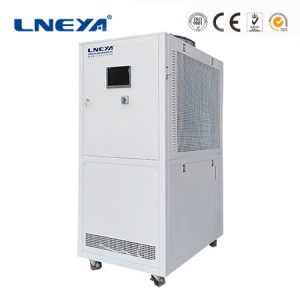Precautions for installation of special chiller for new energy testing
The installation of the special chiller for new energy testing is an important link before operation. The quality of the installation is directly related to the operation and operation status of the special chiller for new energy testing. So, what should be paid attention to in the installation of the special chiller for new energy testing?
If the special chiller for new energy test adopts semi-hermetic or fully-hermetic compressor, an oil separator should be installed, and an appropriate amount of oil should be added to the installed oil separator. When the evaporation temperature is lower than -15 degrees, a gas-liquid should be installed. Separator and add appropriate amount of refrigeration oil. Secondly, the compressor base should be installed with a shock-absorbing rubber seat, and the installation of the special chiller for new energy testing should leave a maintenance space to facilitate the observation of the adjustment of instruments and valves.
The high pressure gauge of the special chiller for new energy testing should be installed at the tee of the liquid storage and filling valve. The overall layout of the special chiller for new energy testing is reasonable and the color is the same. The installation structure of each type of unit should be consistent.
When debugging the special chiller for new energy test, it is necessary to pay attention to measuring the power supply voltage, measuring the resistance value of the three windings of the compressor and the insulation of the motor, checking the opening and closing of each valve of the refrigeration system, and pouring the refrigerant into the storage liquid to the standard charge after evacuation. 70%-80% of the filling volume, and then run the compressor, add air from low pressure to enough volume.
After the special chiller for new energy test is turned on, first listen to whether the sound of the compressor is normal, check whether the condenser and air cooler are running normally, and whether the three-phase current of the compressor is stable. After the special chiller for new energy test cools down smoothly, check the exhaust pressure, suction pressure, exhaust temperature, suction temperature, motor temperature, crankcase temperature, and expansion valve temperature in the refrigeration system, and observe the frosting of the evaporator and expansion valve. , observe the oil level and color change of the oil glass. Check whether the sound of the special chiller for new energy testing is abnormal.
Another point is that the special chiller for new energy testing needs to pay more attention to its maintenance knowledge and carry out a lot of related maintenance work.
Related recommendations
-
Application of supporting experimental equipment for refrigeration and heating system
1754The mixing tank with jacket and insulation layer is a three-layer insulation mixing tank with heating function, which has the functions of heating, insulation, mixing, etc. It is widely used in dairy, chemical, food, beverage, pharmaceutical, phar...
View details -
Low temperature chiller unit in the production of PGA catalyst auxiliary materials
1212Low temperature chillers play an important role in the production reaction process of polyglycolic acid (PGA) and its catalysts and additives. The synthesis and post-treatment process of polyglycolic acid often involve exothermic reactions, ...
View details -
How does the cooling and heating system achieve simultaneous temperature control?
1542Temperature control system The thermostat has heating and cooling functions, and can use the same medium for continuous temperature control from -120℃~320℃. The heating and cooling system of cooling and heating system is mainly composed of four pa...
View details -
Industrial grade heating and cooling system placement attention
1846Industrial-grade heating and cooling system Before the power is turned on, check whether the voltage specified on the nameplate is the same as the household voltage. The same can be used to arrange separate power lines and special sockets for the ...
View details
 LNEYA Industrial Chillers Manufacturer Supplier
LNEYA Industrial Chillers Manufacturer Supplier












